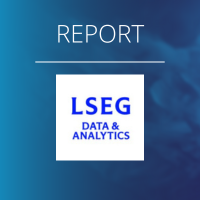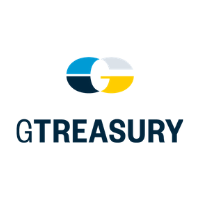Tariffs, FX Volatility, and Treasury Uncertainty: 3 Ways to Navigate this New Normal
By GTreasury
The global trade landscape is shifting—quickly. As tariffs resurface as a major economic lever, supply chains are bracing for impact. The result? Disrupted payment cycles, unpredictable cash flow, and increased FX volatility. For treasury teams, this isn’t just another policy change. This is a full-scale stress test of liquidity strategy.

Companies relying solely on working capital solutions like receivables financing are missing the bigger picture. The real game-changer is dynamic cash forecasting. Why? Because in times of uncertainty, treasury leaders don’t just need visibility. They need foresight.
The True Cost of Tariffs: What Treasury Teams Must Prepare For
When tariffs increase, the impact on corporate finance isn’t just about higher costs. The ripple effects extend into cash flow stability, payment timing, and currency exposure. Treasury teams must consider:
- Working Capital Strain: Tariff-induced cost hikes disrupt supplier payment terms, inventory financing, and liquidity reserves. Without precise forecasting, businesses risk unexpected shortfalls—and costly last-minute financing.
- FX Volatility Amplified: Trade tensions don’t just impact goods; they shake global currencies, making hedging strategies harder to predict. Sudden shifts in exchange rates can erode profit margins, impact pricing models, and disrupt cash repatriation strategies.
- Supply Chain Payment Disruptions: Suppliers adjusting to tariff costs may change pricing structures, shorten payment terms, or require upfront payments, affecting cash positions. Without a forward-looking liquidity plan, businesses may face unnecessary working capital strain.
A reactive approach to cash management is no longer viable. Treasury teams need to model these challenges before they materialize.
Turning Treasury Uncertainty into Opportunity
1️. Scenario-Test Tariff Impacts Before They Hit
Leading treasury teams aren’t waiting for tariffs to be implemented—they are already running “what-if” simulations to measure the financial impact.
- How will increased supplier costs affect cash flow?
- What’s the optimal payables strategy under different trade policy shifts?
- If key suppliers are affected, how do we optimize liquidity buffers?
Companies that stress-test cash flow assumptions in advance can adjust supplier payment strategies, renegotiate financing terms, or seek alternative trade routes before cash flow disruption occurs.
Key Takeaway: Treasury teams should integrate cash forecasting tools that allow for real-time scenario modeling, ensuring rapid adjustments when policies change.
2️. Strengthen FX Risk Mitigation with Cash Forecasting
Tariff uncertainty doesn’t just impact costs—it fuels foreign exchange volatility, compounding risk for businesses with global operations.
Companies need an FX-embedded treasury strategy that includes:
- Scenario-based cash positioning: Forecasting models should include currency fluctuations, helping treasury teams plan for potential exchange rate impacts.
- Hedging strategy alignment: A strong FX strategy requires real-time visibility into exposure, allowing businesses to hedge currencies more effectively.
- Cross-border payment optimization: Companies operating in multiple markets must forecast how tariff-driven FX shifts will impact liquidity and capital allocation strategies.
Ignoring FX volatility can be costly. A data-driven, cash forecasting approach helps businesses proactively manage currency risk, rather than reacting to losses.
Key Takeaway: Treasury leaders should integrate FX exposure monitoring into cash flow forecasts, ensuring global financial stability despite shifting currency markets. Additionally, businesses should evaluate FX hedging strategies alongside forecasting models to determine when proactive hedging is necessary to offset currency-driven cost increases.
3️. Shift from Static to Real-Time Cash Forecasting
The days of static, spreadsheet-based cash forecasting are over. In an environment where tariff policies change rapidly, treasury teams need:
- Multi-scenario planning – Instead of relying on a single forecast, treasury teams should model multiple possible outcomes based on different tariff scenarios.
- Global cash visibility – With tariffs affecting international trade, full visibility into cross-border cash positions is critical for optimizing liquidity.
Companies that embrace real-time, predictive forecasting gain a powerful competitive advantage—transforming uncertainty into strategic decision-making.
Key Takeaway: Treasury teams should ensure their forecasting technology allows instant recalibration when trade policies shift.
Beyond Resilience: How Cash Forecasting Drives Strategic Growth
Many companies treat treasury management as a defensive function—but in times of uncertainty, the most successful businesses leverage cash forecasting as a strategic growth enabler.
- Instead of fearing tariff risks, companies should identify liquidity opportunities.
- Instead of reacting to FX shifts, treasury teams should actively shape hedging strategies.
- Instead of struggling with payment disruptions, businesses should model multiple outcomes and build resilience.
Companies that view treasury management as a proactive function are better positioned to seize opportunities, strengthen financial agility, and outperform competitors.
Key Takeaway: Treasury leaders who invest in advanced, real-time forecasting technology will not only survive trade uncertainty—they will lead through it.
Future-Proofing Treasury Strategy Starts Now
Tariffs and FX volatility are reshaping financial risk management. Companies that rely on outdated forecasting methods or surface-level working capital solutions will struggle to adapt.
The solution? Smarter, more dynamic cash forecasting. Is your treasury team prepared for the next wave of trade volatility?
Discover how GTreasury’s forecasting solutions help leading companies stay ahead of uncertainty.
Can’t get enough? Check out these latest items
 https://treasuryxl.com/wp-content/uploads/2025/12/Copy-of-Live-Session-Nomentia-1.png
200
200
treasuryXL
https://treasuryxl.com/wp-content/uploads/2018/07/treasuryXL-logo-300x56.png
treasuryXL2025-12-19 08:49:372025-12-19 09:41:43Recap & Recording: Corporate Treasury in 2026 and beyond
https://treasuryxl.com/wp-content/uploads/2025/12/Copy-of-Live-Session-Nomentia-1.png
200
200
treasuryXL
https://treasuryxl.com/wp-content/uploads/2018/07/treasuryXL-logo-300x56.png
treasuryXL2025-12-19 08:49:372025-12-19 09:41:43Recap & Recording: Corporate Treasury in 2026 and beyond https://treasuryxl.com/wp-content/uploads/2024/01/Template_VACANCY-featured.png
200
200
treasuryXL
https://treasuryxl.com/wp-content/uploads/2018/07/treasuryXL-logo-300x56.png
treasuryXL2025-12-19 08:20:412025-12-19 08:20:41Vacancy Service Operations Manager (Treasury Tech) – Vienna
https://treasuryxl.com/wp-content/uploads/2024/01/Template_VACANCY-featured.png
200
200
treasuryXL
https://treasuryxl.com/wp-content/uploads/2018/07/treasuryXL-logo-300x56.png
treasuryXL2025-12-19 08:20:412025-12-19 08:20:41Vacancy Service Operations Manager (Treasury Tech) – Vienna https://treasuryxl.com/wp-content/uploads/2025/12/FinanceKey-Featured-1.png
200
200
treasuryXL
https://treasuryxl.com/wp-content/uploads/2018/07/treasuryXL-logo-300x56.png
treasuryXL2025-12-18 07:00:142025-12-18 18:17:55Pivoting in FinanceKey: turn raw data into instant insight
https://treasuryxl.com/wp-content/uploads/2025/12/FinanceKey-Featured-1.png
200
200
treasuryXL
https://treasuryxl.com/wp-content/uploads/2018/07/treasuryXL-logo-300x56.png
treasuryXL2025-12-18 07:00:142025-12-18 18:17:55Pivoting in FinanceKey: turn raw data into instant insight https://treasuryxl.com/wp-content/uploads/2025/08/LSEG-BLOGS-featured-10.png
200
200
treasuryXL
https://treasuryxl.com/wp-content/uploads/2018/07/treasuryXL-logo-300x56.png
treasuryXL2025-12-17 07:00:252025-12-16 08:55:07Test Data as a Service
https://treasuryxl.com/wp-content/uploads/2025/08/LSEG-BLOGS-featured-10.png
200
200
treasuryXL
https://treasuryxl.com/wp-content/uploads/2018/07/treasuryXL-logo-300x56.png
treasuryXL2025-12-17 07:00:252025-12-16 08:55:07Test Data as a Service https://treasuryxl.com/wp-content/uploads/2023/03/Treasurer-Search-Logo.png
200
200
treasuryXL
https://treasuryxl.com/wp-content/uploads/2018/07/treasuryXL-logo-300x56.png
treasuryXL2025-12-16 09:27:252025-12-16 09:27:25Interim Treasury Manager @ Treasurer Search
https://treasuryxl.com/wp-content/uploads/2023/03/Treasurer-Search-Logo.png
200
200
treasuryXL
https://treasuryxl.com/wp-content/uploads/2018/07/treasuryXL-logo-300x56.png
treasuryXL2025-12-16 09:27:252025-12-16 09:27:25Interim Treasury Manager @ Treasurer Search https://treasuryxl.com/wp-content/uploads/2025/06/Nirav-Interview-1.png
200
200
treasuryXL
https://treasuryxl.com/wp-content/uploads/2018/07/treasuryXL-logo-300x56.png
treasuryXL2025-12-16 07:00:212025-12-15 12:30:31Stablecoins: The Silent Revolution Is Already Here
https://treasuryxl.com/wp-content/uploads/2025/06/Nirav-Interview-1.png
200
200
treasuryXL
https://treasuryxl.com/wp-content/uploads/2018/07/treasuryXL-logo-300x56.png
treasuryXL2025-12-16 07:00:212025-12-15 12:30:31Stablecoins: The Silent Revolution Is Already Here https://treasuryxl.com/wp-content/uploads/2024/02/Featured_Treasurer-Search.png
200
200
treasuryXL
https://treasuryxl.com/wp-content/uploads/2018/07/treasuryXL-logo-300x56.png
treasuryXL2025-12-15 07:00:062025-12-19 08:28:55The Future of Financial Messaging: Migrating from MT940 to ISO 20022
https://treasuryxl.com/wp-content/uploads/2024/02/Featured_Treasurer-Search.png
200
200
treasuryXL
https://treasuryxl.com/wp-content/uploads/2018/07/treasuryXL-logo-300x56.png
treasuryXL2025-12-15 07:00:062025-12-19 08:28:55The Future of Financial Messaging: Migrating from MT940 to ISO 20022 https://treasuryxl.com/wp-content/uploads/2025/09/Nomentia-BLOGS-featured-5.png
200
200
treasuryXL
https://treasuryxl.com/wp-content/uploads/2018/07/treasuryXL-logo-300x56.png
treasuryXL2025-12-12 12:54:092025-12-12 13:07:57Nomentia Announces Leadership Transition to Drive Next Phase of Growth
https://treasuryxl.com/wp-content/uploads/2025/09/Nomentia-BLOGS-featured-5.png
200
200
treasuryXL
https://treasuryxl.com/wp-content/uploads/2018/07/treasuryXL-logo-300x56.png
treasuryXL2025-12-12 12:54:092025-12-12 13:07:57Nomentia Announces Leadership Transition to Drive Next Phase of Growth https://treasuryxl.com/wp-content/uploads/2023/03/Treasurer-Search-Logo.png
200
200
treasuryXL
https://treasuryxl.com/wp-content/uploads/2018/07/treasuryXL-logo-300x56.png
treasuryXL2025-12-11 14:07:112025-12-18 11:06:12Sales Director Investments @ Treasurer Search
https://treasuryxl.com/wp-content/uploads/2023/03/Treasurer-Search-Logo.png
200
200
treasuryXL
https://treasuryxl.com/wp-content/uploads/2018/07/treasuryXL-logo-300x56.png
treasuryXL2025-12-11 14:07:112025-12-18 11:06:12Sales Director Investments @ Treasurer Search


